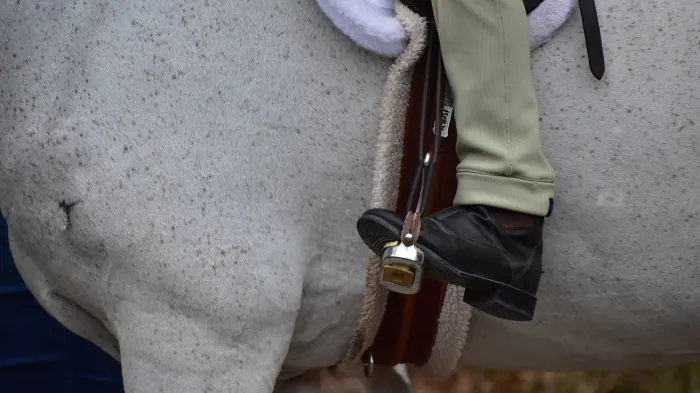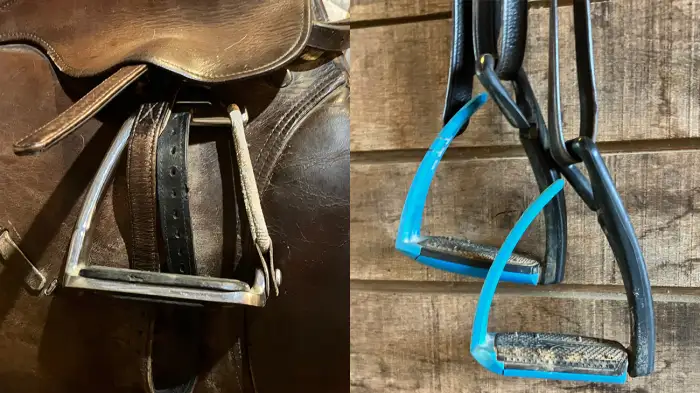Want to ‘stirrup’ a lesson barn controversy? Start talking about banning peacock stirrups.
That’s exactly what’s happening now that both the U.S. Pony Clubs and U.S. Equestrian Federation have announced rule changes prohibiting the use of peacock stirrups in their recognized events. While the intent behind these changes is clear—enhancing rider safety—the ripple effects are being felt far beyond the competition ring, especially in lesson programs that cater to beginner and intermediate riders.
Peacock stirrups have long been a staple in English riding schools. Their simple hook-and-loop design with an elastic band is widely recognized, affordable and easy to use. For decades, they’ve been a go-to safety choice, marketed as a way to prevent foot entrapment in the event of a fall. But their widespread use for safety is now under scrutiny.

Why The Ban?
The catalyst for change in Pony Club came after the USPC Safety Committee reviewed firsthand reports of injuries linked to peacock stirrups. In its January 2025 rule update, it stated:
“Peacock stirrups… were originally designed to release if a rider fell so that they wouldn’t get their foot caught in the stirrup. There is a history of riders who have gotten caught on the upward-pointing hook while sliding down the saddle during a dismount. In some instances, clothing has been torn, as well as skin, causing horrific injuries to the rider, some that required surgery or resulted in permanent injury.”
USEF also has a rule going into effect Dec. 1, 2025:
“Saddle attachments with rigid upward projections that may catch a rider’s clothing will be prohibited (e.g., peacock stirrups). … Modern equestrian apparel includes more stretchy fabrics, which are more likely to result in the possibility of getting caught or hung on hooks or other protrusions.”
With two well-respected organizations in U.S. equestrian sport sounding the alarm, lesson barns are left with urgent questions—and no easy answers.
The Cost Of Compliance
For many riding programs, especially those serving large numbers of novice riders or operating on slim margins, this rule change poses serious financial challenges.
Peacock stirrups typically retail for around $50 a pair. Many of the recommended alternatives range from $150 to $500. Multiply that cost across a barn of 10–20 saddles, and you’re facing equipment upgrades that are not feasible for a lot of programs.
ADVERTISEMENT
That’s assuming a clear replacement exists. But here’s the catch: There is no definitive research pointing to which safety stirrups actually work best.
Are We Trading One Risk For Another?
Many instructors are wondering: Are we solving the right problem—or just shifting risk elsewhere?
Both USPC and USEF cite injury from clothing getting caught on the metal hook of peacock stirrups, often during dismount. But that particular risk could potentially be reduced by simply teaching riders to cross their stirrups and focus on improved dismount technique.
Then there’s the original purpose of the peacock stirrup: preventing the foot from being trapped during a fall. While they’ve never been foolproof, plenty of anecdotal reports show they’ve done exactly what they were designed to do. At the same time, social media and online forums show that even the most modern “safety” stirrups aren’t immune to foot entrapment.
Without comparative injury data, instructors are left to wonder: Are we really upgrading safety or just keeping up with styles?
Where’s The Research?
After digging into this topic for hours, I was struck by how little concrete data exists. Most safety stirrups are backed by marketing language, not independent testing. There’s no industry-wide protocol for evaluating their effectiveness, and no central database tracking stirrup-related injuries.
The most valuable resource I uncovered was a 2024 master’s thesis from Sweden by Karin Björnson titled “Safety Stirrups: Investigation of Safety Stirrup and the Development of Tests.” In it, Björnson confirms what many instructors have long suspected: There is no standardized method for testing stirrup safety, and no comprehensive injury data comparing one design to another.
Her thesis calls for the equestrian industry to adopt testing models similar to helmet safety research: controlled environments, measurable outcomes and third-party oversight. Until that happens, we’re operating in a vacuum of evidence, relying more on perception than proof.

Navigating Liability In A Shifting Landscape
In the absence of clear standards, lesson programs are now navigating a grey area filled with questions about risk, ethics, and liability. If a barn chooses to continue using peacock stirrups and an injury occurs, will that now be seen as negligent?
Some barns are preemptively replacing stirrups to reduce potential liability. Others are holding off, unwilling to invest in unproven alternatives or unable to afford the sudden cost. Either way, the pressure is real—and it’s falling hardest on the programs that serve entry-level riders, the very foundation of the sport.
ADVERTISEMENT
What Should Happen Next?
To be clear, I am not arguing for or against any specific stirrup design. Instead, my intent is to call for a more evidence-based approach to rider safety.
If the equestrian world is ready to rethink safety stirrups, then we must also be ready to invest in the science behind that change. That means:
• Funding independent research on stirrup performance in real-world fall scenarios.
• Creating standardized testing protocols akin to helmet safety ratings.
• Collecting and sharing transparent injury data across disciplines.
• Involving riding instructors—especially those in lesson programs—in safety discussions and decisions.
Because until we do, every decision will carry a level of guesswork, and every policy change will land hardest on those least equipped to absorb the cost.
In The Meantime…
Instructors are left making tough decisions. Do we replace affordable stirrups with expensive alternatives that may or may not be safer? Do we continue using equipment flagged as unsafe by governing bodies and risk legal repercussions? Or do we focus more on things like better dismounts, proper footwear, boot to stirrup size, stirrup-cramp position and appropriate stirrup leathers—and hope that’s enough?
Ultimately, safety doesn’t come from a single piece of equipment. It comes from a layered approach: thoughtful instruction, appropriate gear, sound policies, and yes—evidence-based standards. As rule changes inadvertently encourage the phasing out of one type of stirrup, we should be equally committed to phasing in a culture of inquiry and accountability for our industry as a whole.
The views expressed in opinion pieces are those of the writers and do not necessarily reflect those of The Chronicle of the Horse.
Heather Henken is the founder of Instructor Half Halt, a platform offering education and mentorship for riding instructors. She travels the country sharing over 20 years of professional experience in the equine industry. Heather holds teaching certifications through ARIA and PATH Intl., and she previously worked as a licensed equine insurance agent, bringing a unique perspective on safety and risk management.














